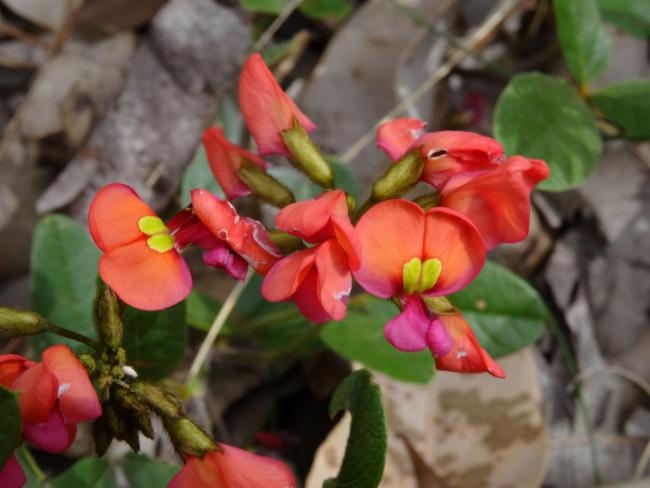Coral Vine
(Kennedia coccinea)
Coral Vine (Kennedia coccinea)
/
/

Joel Collins
CC BY 4.0
Image By:
Joel Collins
Recorded By:
Copyright:
CC BY 4.0
Copyright Notice:
Photo by: Joel Collins | License Type: CC BY 4.0 | License URL: http://creativecommons.org/licenses/by/4.0/ | Occurence ID: https://www.gbif.org/occurrence/1632972865 | Publisher: Atlas of Living Australia |












Estimated Native Range
Summary
Kennedia coccinea, commonly known as Coral Vine, is an evergreen perennial vine native to a variety of habitats including open woodlands, coastal dunes, and scrublands in Western Australia. It can grow to a height of 7-10 feet (2.1-3 meters) and a width of 2-3 feet (0.6-0.9 meters), with a twining habit that allows it to climb structures and cover ground effectively. The plant is known for its vibrant and showy pea-like flowers that appear in a range of colors including yellow, orange, pink, and red, mainly during the spring season.
Coral Vine is valued for its drought resistance and ability to thrive in sandy or lighter soils, making it suitable for xeriscaping and coastal gardens. It is also frost tolerant to a degree. In cultivation, it is often used for covering trellises, fences, and as a ground cover in areas with full sun to partial shade. While it prefers some shade in hotter climates, it is adaptable and can tolerate low water conditions once established. Propagation is typically done by scarified seed or cuttings of semi-mature growth. Gardeners should be aware that in some regions, it can become invasive, so monitoring and control may be necessary to prevent unwanted spread.CC BY-SA 4.0
Coral Vine is valued for its drought resistance and ability to thrive in sandy or lighter soils, making it suitable for xeriscaping and coastal gardens. It is also frost tolerant to a degree. In cultivation, it is often used for covering trellises, fences, and as a ground cover in areas with full sun to partial shade. While it prefers some shade in hotter climates, it is adaptable and can tolerate low water conditions once established. Propagation is typically done by scarified seed or cuttings of semi-mature growth. Gardeners should be aware that in some regions, it can become invasive, so monitoring and control may be necessary to prevent unwanted spread.CC BY-SA 4.0
Plant Description
- Plant Type: Vine
- Height: 7-10 feet
- Width: 2-3 feet
- Growth Rate: Moderate
- Flower Color: Yellow, Orange, Pink, Red
- Flowering Season: Spring
- Leaf Retention: Evergreen
Growth Requirements
- Sun: Full Sun
- Water: Low
- Drainage: Medium
Common Uses
Bee Garden, Bird Garden, Butterfly Garden, Drought Tolerant, Hummingbird Garden, Low Maintenance, Potted Plant, Salt Tolerant, Showy Flowers, Street Planting
Natural Habitat
Open woodlands, coastal dunes, and scrublands in Western Australia
Other Names
Common Names: Coralvine
Scientific Names: , Kennedia coccinea, Kennedya coccinea, Glycine coccinea, Kennedia inophylla, Zichya coccinea, Caulinia coccinea, Caulinia eximia, Kennedia dilatata, Kennedya dilatata
GBIF Accepted Name: Kennedia coccinea (Curtis) Vent.